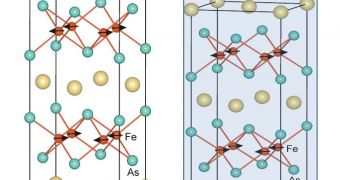Material known as iron-based superconductors may have just been brought one step closer to practical applications and widespread use, thanks to an achievement managed by investigators at the University of Maryland and the US National Institute of Standards and Technology (NIST).
The group was able to discover a member of this class of materials that is capable of operating at the highest-known temperatures. Details of the study appear in a paper entitled “Structural collapse and superconductivity in rare-earth-doped CaFe2As2.”
The work is published in the January 13 issue of the esteemed scientific journal Physical Review B. Unlike other superconductors, the iron-based variety is a lot easier to manufacture, and features a host of other properties that make it desirable.
It was only four years ago that physicists discovered these materials even existed. At this point, many science teams around the world are investigating their properties. Copper-based superconductors are the staple today, but they may soon get replaced.
Oftentimes, these materials are very brittle, plus they are very expensive to produce. When it comes to iron-based superconductors, there are four main classes, of which the one called 1:2:2 is the most promising. All members belonging to this class build their crystals around a central hub.
This core is made up of one atom of calcium, two atoms of iron and two arsenic atoms, and is very prone to tailoring after specifications, due to the ease with which each of these elements may be substituted by others.
During the new study, experts discovered that the threshold temperature of superconductivity in the 1:2:2 class is 47 degrees Kelvin (minus 226 degrees Celsius, or minus 375 degrees Fahrenheit). The previous record was 38K (-235ºC, or -391ºF).
The team was based at UM and the NIST Center for Neutron Research (NCNR). The latter facility was used because it has the necessary equipment to conduct in-depth neutron scans of the material's structural arrangement.
Interestingly, some 1:2:2 iron-based superconductors can collapse during the atomic substitution process, reducing their overall size by as much as 10 percent. Manufacturers will want to prevent this from happening; the team says it already has a solution.
The collapse is “almost like what would happen if you cut off a few inches from the bottom of your chair’s legs. The crystal just collapses. The change is quite visible in neutron scans,” NCNR expert investigator Jeff Lynn explains.

 14 DAY TRIAL //
14 DAY TRIAL //